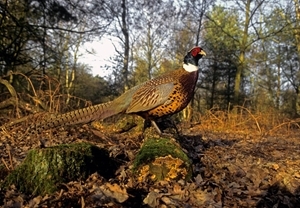 Pheasants have been closely associated with woodlands in Britain since the 16th Century, when they became important as a quarry species. Game managers have long recognised the importance of woods for holding pheasants on their properties through the autumn and winter, and literature dating back to the 19th Century details how woodlands can be managed for pheasants and pheasant shooting. Despite a national trend of loss of large areas of farm woodland to agriculture and urbanisation in the second half of the 20th Century and a reduction in the levels of management in remaining farm woodlands because they were often no longer economically viable, game managers have retained, managed and planted woodlands for the specific purpose of providing habitat and favourable shooting conditions for pheasants. Many landowners and game managers invest considerable resources in woodland management to support pheasant shoots.
Pheasants have been closely associated with woodlands in Britain since the 16th Century, when they became important as a quarry species. Game managers have long recognised the importance of woods for holding pheasants on their properties through the autumn and winter, and literature dating back to the 19th Century details how woodlands can be managed for pheasants and pheasant shooting. Despite a national trend of loss of large areas of farm woodland to agriculture and urbanisation in the second half of the 20th Century and a reduction in the levels of management in remaining farm woodlands because they were often no longer economically viable, game managers have retained, managed and planted woodlands for the specific purpose of providing habitat and favourable shooting conditions for pheasants. Many landowners and game managers invest considerable resources in woodland management to support pheasant shoots.
The detailed habitat requirements of pheasants were not determined until relatively recently. In the 1980s the GWCT showed that pheasants prefer small woodlands with a high proportion of shrubby cover 30-200cm tall and a shrubby woodland edge. Depending on the type of wood, there are a number of ways in which these conditions can be created or enhanced. These include traditional coppicing, sky-lighting to create favourable conditions for the regrowth of the under-storey vegetation or planting shade-tolerant shrubs in woodlands with closed canopies.
These are techniques which are likely to benefit other wildlife, including songbirds and butterflies. Many woodland songbirds, particularly migrant species, occur in greater densities in shrubby woodland. Recent research has shown that many of these woodland species are declining (Fuller et al., 2005), and a reduction in the amount of under-storey vegetation in woodlands has been cited as a possible cause of these declines. While it is generally recognised that managing woodlands for pheasants may benefit aspects of woodland biodiversity, there is little direct evidence to demonstrate this.